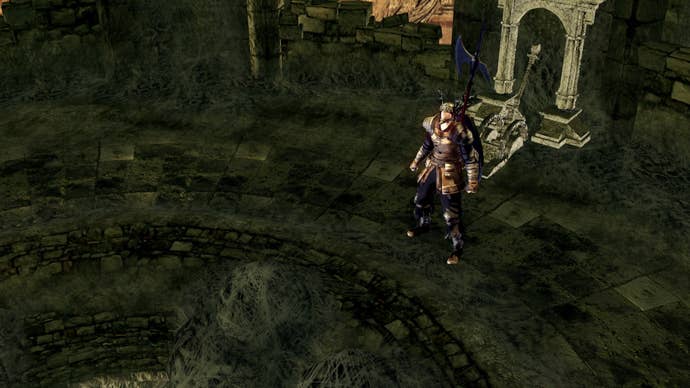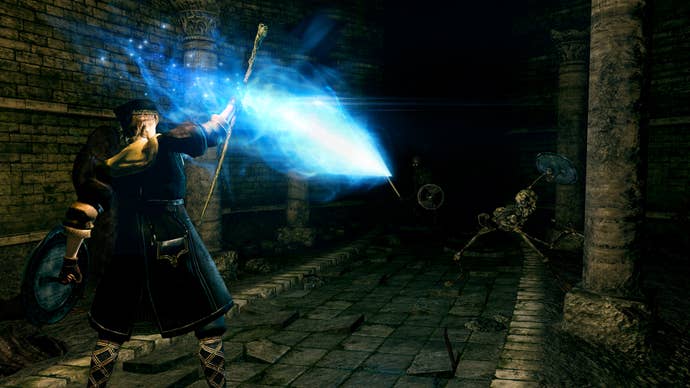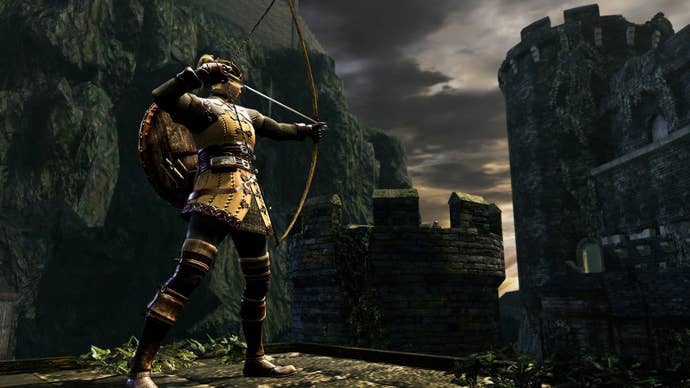Dark Souls Remastered Review - Nintendo Switch Update
From Software finds a classic sitting next to a forgotten bonfire. This review now includes impressions of the Nintendo Switch version of Dark Souls Remastered.
This article first appeared on USgamer, a partner publication of VG247. Some content, such as this article, has been migrated to VG247 for posterity after USgamer's closure - but it has not been edited or further vetted by the VG247 team.
Editor's Note: After a significant delay, the long-awaited Switch version of Dark Souls Remastered is out on October 19, 2018. What follows is USgamer's original review of the game with our new Switch impressions immediately afterward.
Do you like Batman? I love Batman. We should talk about Batman.
Of course, I’m not talking about Batman the character, but he’s a cool guy, too. Relevant to this conversation is that we need to talk about Batman for the Nintendo Entertainment System. Released in 1989 from Japanese developer/publisher Sunsoft, it was the rare licensed tie-in that decided to also be a thrilling action platforming game. Sure, there were nods to the blockbuster Tim Burton movie that it was meant ride the coattails of, but it isn’t unfair to call Batman a frequently challenging, often beautiful and wholly engrossing piece of the medium in its time. Perhaps not a diamond compared to some of its contemporaries, but certainly a polished jewel of the 8-bit age.
It’s sad—frankly, it sucks—that you will never legally play Batman again barring a hunt for a working NES and a copy of the game. Sunsoft is a shell of the company it was in the late 1980s, and the odds that Warner Bros., who owns DC Comics and thus the Dark Knight himself, are going to find it within themselves to provide new licensing rights for the game are longer than making a full-court shot while riding a unicorn in celebration of world peace. Batman for NES will continue to pass into memory, its legacy fading as it drifts into footnote territory. This is not an uncommon sample. This is a big problem for video games as a medium.

To contrast the example a little bit, it’s hard not to have a conversation about modern video games without bringing up Dark Souls. From the game’s reach with developers in terms of design to its omnipresence in internet conversation, Dark Souls has gone from industry touchstone to obnoxious comparison trope and back again. Even if you think this paragraph is the Dark Souls of Dark Souls paragraphs, it cannot be denied that developer From Software took what they learned from Demon’s Souls nearly a decade ago and made something so special that we can even make that (dumb) joke. Often imitated but never matched, even with its own sequels according to some, there is nothing quite like Dark Souls. It is a diamond compared to its contemporaries, and it should be preserved.
This is the primary reason that Dark Souls Remastered exists. It takes a brilliant game and keeps it accessible. While it may not be possible to future-proof individual games for generations to come, Remastered lets you put your PlayStation 3 or Xbox 360 in the attic. It allows you to give up the fight to keep an aging and broken PC port functional when you change hardware. It keeps the game you know readily available, and affords those that never had the chance to play it the first time around a new opportunity.

It does so by leaving Dark Souls in its best possible state. The funny thing about writing this review is that I had to force myself to play this game again from scratch. From the outside looking in, that seems pedantic, but hear me out; I have played Dark Souls before. I’ve played Dark Souls a lot, but I haven’t gone front-to-back with it since maybe my first time. That was always part of both its allure and its majesty; though interwoven with each other, most of the game’s individual subsections are tiny masterpieces of level design. Part of the complex puzzle box that are Souls games, then, is to find ways to efficiently worm through them. This meant routinely skipping locations and environments that I never found much use for.
For its part, my PlayStation 3 was happy I did. Dark Souls never ran well–its most famous example a swampy shantytown not far past the starting areas that ratchets down the framerate to single-image slideshows—and when plowing through the game for any variety of reasons, it’s easy to find yourself without the patience for that sort of thing. Remastered fixes all that, and has the game humming along at a consistent framerate so even its largest and most crowded areas never stutter.
To someone not already familiar with the game, the ability to play it with this kind of stability may not seem like something to celebrate. It’s common enough to have games running at a consistent 30 or 60 frames per second these days that taking the time to point this out isn’t a big deal. But Dark Souls is an experience built around tension. A player’s first trip through its murky swamps and sunlit cathedrals is a crash course in nervous terror, as enemies pop out of seemingly unexpected places. A console choking on code that slows frame rates to a crawl would make enemy encounters feel cheap in some of the more problematic areas. By design, certain locations obscure the camera to mess with the player, which can be frustrating on its own. Fighting with poor system performance only made things worse. This is Dark Souls Remastered’s chief accomplishment, and makes for a better game overall.

The fresh coat of paint doesn’t hurt, but it wasn’t as necessary. Certainly, Dark Souls is an aging game with graphics to match. Any side-by-side comparisons between it and current-gen From Software games with their copious particle effects and cluttered environments makes it look sparse, almost workmanlike. Naturally, then, Remastered cleans up textures and adjusts the lighting of some locations.
The game has a new sort of sheen and glimmer now in full 1080p compared to the original’s 720p. Bloodstains on the ground feel more like blotches of polygons, when they had an element of muddy scum originally. Surfaces have a more reflective quality to them, and small touches like flickering flames on the bonfires are an improvement that longtime players will notice right away.
Some locations, though, like the sunny Anor Londo, feel more artificial and angular now with the improved lighting and cleaner textures. Light to dark contrasts in some environments also tend to be more extreme to the point that I needed to adjust the brightness of the game from the options menu more than once. From an artistic standpoint, the game will never look better; we can get views of, say, the Capra Demon’s face and body that show added details that may not have been originally clear. But for those that expected something more, this isn’t a dramatic overhaul.

The minor quality of life improvements will probably only cater to the hardcore Souls players. Multiple consumables can now be used at once in Remastered, which saves some time fiddling with menus. The HUD can be easily removed for those that want either a more challenging game or for making cleaner YouTube videos. These are fine, if not foundational changes that the game could have always used but never really needed.
The inclusion of more online players in a single session will be absolutely game changing to the Souls community’s PvP crowd. Where the original game only had room for a player, two summoned helpers, and one enemy invader, the online entrants have now been boosted to a total of six for more lively skirmishes. Sadly though, I never had the opportunity to summon a full crowd during the pre-release. In the times I did bring in some extra help, summoned players entered my game at a snappier pace. Likewise, when I was summoned into another player’s game, the loading times felt shorter as I connected more easily to a host, and I never stuttered or clipped through players or enemies like before.

For returning players though, there isn’t anything else brand-new to entice them. Adjustments to movement and exploration, even minor ones like sliding down ladders, haven’t been included. Rolling around in combat, like the original game, is still locked in four cardinal directions, and not the adjusted eight found in later games. Backstabbing will easily connect to opponents online and off, and will feel substantially more powerful here than what someone might find in Dark Souls III. And no, there aren’t any new weapons, adjusted stats (that I could surmise), or other additional content.
I contend that there doesn’t need to be, as does Dark Souls Remastered. This release of the game is its own sort of Age of Fire rekindled; it is easily accessible for new and old players alike, featuring an engine purring with a precision it never had. Returning true believers may be a bit disappointed at the lack of new content, but the fact that it is re-released at all and in such good shape is a good indication that some all-timers like Dark Souls can be enjoyed and scrutinized for many more years to come. If this game isn’t already in your collection, it should be, and this is the version to get.
Matt Kim, Nintendo Switch Update

I spent the past week with the Switch version of Dark Souls Remastered. Considering Dark Souls is one of my favorite games of any generation, I could go on about its artistic achievements. However, this review of the Switch version largely focuses on the technical aspects as the biggest question ahead of this version is: "How well does it play on Nintendo’s hybrid console?" Surprisingly well actually, at least in handheld mode.
During my time with Dark Souls Switch I can confidently say that I’ve have had little to no problems with From Software’s dark and twisted fantasy. There were no noticeable framerate issues even during gargantuan boss fights. How Dark Souls played while in handheld mode is nothing short of exemplary.
While I couldn’t finish the entire game in time for this review amendment, I wanted to reach the infamous Blighttown as that was my biggest point of concern going into Dark Souls Remastered for Switch. Blighttown’s effect on Dark Souls' framerate is well-documented, but the problem was corrected in the PS4 and Xbox One versions of Remastered. I still had doubts about the Switch version.

It turns out that my fears were unwarranted and Blighttown performed even better than I had anticipated. Review versions of Dark Souls Remastered for Switch did not come with the online functionality turned on however, so it remains to be seen if that can impact the game’s overall performance.
Graphically, Dark Souls Switch in handheld mode resembles its PS3/Xbox 360 counterpart more so than the recent Dark Souls Remastered edition on PS4, Xbox One, and PC. That is to say, Dark Souls looks excellent so long as you’re not expecting the most current standards of graphical fidelity while in the handheld mode.
One thing I should mention with the controls is that Dark Souls on Switch mirrors the controller layout on the PlayStation version. This means you have to press the "B" button on the Switch as it takes the place of the "X" button on the DualShock. This can get pretty confusing early on but I found the best solution is to psychically superimpose the DualShock button layout onto the Joy-Con with your mind's eye.

There’s actually couple of reasons I haven’t discussed Dark Souls Remastered for Switch in docked mode. If I wanted to play Dark Souls on a TV, either the PS4 or Xbox One versions are a better choice. Being able to play Dark Souls anywhere you want is the main appeal of the Switch version, and honestly, it’s really the way to go. I’ve been primarily playing Dark Souls in bed and I’ve never had a better time revisiting Anor Londo.
That said, here’s the lowdown about Dark Souls Remastered in docked mode. Visually, it gets a noticeable bump when hooked up to a television set that makes it comparable to Dark Souls Remastered on PS4 and Xbox One, even if its falls short. However, review instructions from the publisher were very keen that any video capture for Dark Souls Remastered on Switch was from the handheld version, and it turns out that’s because there’s a strange issue with the camera when it's in docked mode.
The camera controls become noticeably laggy when the Switch version is docked, and this issue doesn’t exist at all when Dark Souls is in handheld mode. Bandai Namco says that a day one patch should fix many minor issues in the review copy, but it remains to be seen whether this camera issue is one of them. Aside from that glaring flaw, Dark Souls seemed to run fine.
If you are someone who has only ever owned Nintendo consoles, then this will be the first time From Software’s twisted dark fantasy game has been available to you. If you want to see what the hubbub surrounding the Souls series is all about, then I’ll point you to John’s review above and second his thoughts.

If you’re a longtime Dark Souls fan looking to pick it up on yet another platform, I can say that the Switch version genuinely surprised me. Not only does it work, but it works well. And having the ability to take Dark Souls with me wherever I go is honestly a dream come true.
ConclusionWhile bare-bones on the surface, Dark Souls Remastered is one of the best games of the last 20 years running better than it ever has. New players will find all of the mood, challenge, and tension of the original, and returning vets are given beefier online options and minor tweaks to small details. More importantly, it keeps one of the medium’s best games easily accessible and readily available.
